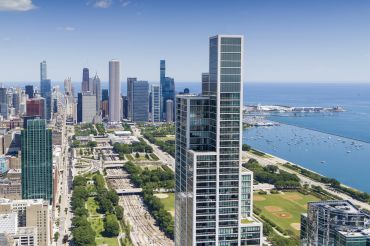NYC CRE Market Entered 2022 With a Lot of Promise and Ends With a Lot of Uncertainty
‘It’s not just the tech pullback, it’s the pullback in the banks, Ukraine, work from home, inflation. You reach a certain number of factors and people just stop sweeping things under the rug.’
By Rebecca Baird-Remba December 12, 2022 2:00 pm
reprints
A year ago, just before the omicron variant of the coronavirus swept New York City, many office landlords believed that New Yorkers would be back in the office full time in 2022 and their pandemic worries would finally come to an end.
But the year did not exactly go as expected, particularly for the office market. A combination of high interest rates, inflation and a slow return to the office have compounded pandemic-era problems for many commercial landlords in the five boroughs. Tech tenants like Meta, which fueled office leasing in Manhattan for the past few years, have also begun to give up hundreds of thousands of square feet of space, putting office owners on edge.
Office leasing, however, did improve throughout the year. Third-quarter leasing totals in Manhattan hit 9.9 million square feet, a 24 percent increase compared to the second quarter of the year, according to Newmark (NMRK). But availability of empty space in Manhattan has stayed much higher than pre-pandemic levels — between 18 and 19 percent this year— as more companies have opted to downsize or give up their offices entirely.
Average asking rents slid from $76 a square foot in the second quarter to $74 a foot in the third quarter. There’s also plenty of office space in the pipeline, with 10 million square feet under construction at sites like 295 Fifth Avenue and 66 Hudson Boulevard.
“The first three quarters of the year in terms of leasing velocity were pretty strong compared to 2021, and then it was like the music stopped,” said David Hoffman, an office leasing broker at Cushman & Wakefield (CWK). “Part of that was a reset by the tech industry, which was one of the big drivers of space absorption in New York City. Now you get on the tenant [rep] list for a 10,000-square-foot law firm and landlords are calling you. That’s illustrative of how the leasing market is right now.”
The question of what to do with older office buildings has plagued landlords and city policymakers for two and a half years. Unrenovated, early- to mid-20th century office towers in the Financial District and Midtown are responsible for much of the unleased space on the market in Manhattan. The east side of the Financial District, which is populated with these kinds of buildings, reports the highest office availability rate in the city, at 26 percent.
So now some of the city’s biggest office landlords have started to embrace the idea of converting office buildings to other uses. Silverstein Properties announced last week that it was raising $1.5 billion to acquire distressed office properties in the city and convert them to apartments. First up is the conversion next year of 55 Broad Street in the Financial District, together with MetroLoft.
“Now is the perfect storm where office is not in favor, and the residential market is very hot,” Silverstein CEO Marty Burger told Bloomberg. “Our acquisition group is solely focused on this right now.”
Even SL Green CEO Marc Holliday, one of the industry’s most vocal return-to-office proponents, said last week at an New York University real estate conference that “the hybrid work model has persisted far longer than I expected it to.” He told the audience that his office buildings were only 60 percent occupied on a typical day. So even as the firm begins to unload office properties to raise cash, it hopes to win a state casino license for its Times Square office tower.
“It was clear in March that there were headwinds that were going to affect the market,” said veteran CBRE investment sales broker Darcy Stacom. “It’s not just the tech pullback, it’s the pullback in the banks, Ukraine, work from home, inflation. You reach a certain number of factors and people just stop sweeping things under the rug.”
She added that “the first half of the year turned out to be quite strong. That came from deals that were closing last year and ones that were closing earlier in the year.” SL Green purchased 450 Park Avenue for $450 million in June, and Empire Capital Holdings acquired 1330 Avenue of the Americas for $325 million in July.
Once interest rates started to rise — the Federal Reserve’s first benchmark increase came in March and accelerated through the summer — it was a different story.
“In the second half of the year, with the lenders largely on the sidelines, it became very hard to trade anything,” said Stacom. As for 2023, “the market’s going to be very challenged in the first half of the year. If we do see interest rates start to come down in the second half of the year, capital will start to surface.”
Even office leasing brokers, normally a glass-half-full bunch, are starting to acknowledge some hard truths.
“No one knows where interest rates will ultimately settle,” said Newmark broker Brian Waterman. “I think that’s a lot of the pause in what you’re seeing. It’s hard to price in where this debt is going to go. Across the board, you need to know your cost of money — if you’re acquiring an asset and taking out short-term debt and thinking ‘Eventually I’ll refinance.’ ”
He noted that “deal concessions are still remaining high, and net effective rents are down.” The depressed office rents are a boon to tenants looking for cheap space, like universities, nonprofits and charter schools, said Waterman, and those are the kinds of users in the market right now.
JLL (JLL)’s Peter Riguardi put it even more bluntly.
“I think at the beginning of ’23 we’re going to start seeing a market correction,” he explained. “You’ll start seeing changes in net effective deals, and then you’ll start seeing landlords change their asking rents.” Already, he said, “we’ve seen people not finishing leases we thought they were going to finish. We’ve seen a lot of sublease space, especially from tech.”
He also felt that office-to-residential conversions would help prop up the city’s office market by removing vacant commercial space and easing the affordable housing crisis.
“Finding affordable housing is a huge obstacle in retaining and recruiting talent,” said Riguardi. “Everyone thinks affordable housing is for people who are having a tough time, but it’s also a tough thing for people who work at places like JLL. So we need to figure out a way to create more affordable housing. Maybe some of those buildings could be converted and it could inspire the retail in Midtown East. We are going to see more people wanting to live in the Manhattan CBDs after these conversions.”
At the other end of the spectrum, the residential market is hotter than it’s ever been. The average apartment rent in Manhattan was up 10 percent year-over-year, to $4,638 in November, according to data from residential brokerage MNS. The average rent for a non-doorman studio has risen nearly 20 percent year-over-year, from $2,466 to $2,955 last month, and non-doorman one-bedrooms are up 14 percent annually, from $3,254 to $3,714. Average rents for their doorman counterparts have risen by a less dramatic 8 percent in the past year.
So residential buildings continued to trade in the latter half of the year, Stacom noted, though at a slower pace than previous years, when interest rates were lower. Indeed, the dollar volume of multifamily transactions in the city rose 37 percent over the past year, to $3.6 billion, in the third quarter of 2022, according to Ariel Property Advisors. Just last week, Black Spruce Management and Orbach Housing Solutions acquired three apartment buildings in Manhattan for $825 million from Sheldon Solow’s estate. RXR, Macquarie Capital and Qatar Investment Authority financed part of the deal with a $261 million equity investment.
Residential developers, meanwhile, spent the first half of the year in a mad rush, trying to meet the deadline for the 421a tax break program. The tax abatement expired June 15, forcing developers to start foundation work by that date in order for their buildings to qualify for reduced property taxes. The New York State Legislature is working on a replacement, and may potentially hammer out a compromise by next spring. But, in the meantime, most real estate observers think the lack of tax exemptions for new development will put a damper on residential projects in more affordable parts of the city.
Retail tends to reflect the city’s residential market, and retail leasing has been going pretty well this year too. It helps that tourism in the city rebounded significantly, with municipal tourism bureau NYC & Company projecting 56.4 million visitors — equal to 85 percent of 2019 numbers — by year’s end.
The number of retail leases signed this year is similar to 2019 levels, but asking rents are still down from where they were pre-pandemic. Asking rents are down 25 to 35 percent from their 10-year average, which was largely driven by a peak in retail rents set in 2017, according to JLL’s Patrick Smith.
“It’s still a very significant discount from what it has been,” Smith said. “In addition to feeling good about the marketplace, retailers are more apt to try things, and they don’t have to project as optimistic a sales expectation to make things work.”
Asking rents for retail have tumbled since the beginning of the pandemic, but “you’re starting to see stabilization and beginning of rent growth” in some parts of the city, Smith noted. SoHo and the Flatiron District have had a particularly robust year in leasing, and the broker estimated that retail vacancy along Broadway in SoHo was less than 15 percent. That’s a dramatic reversal from two years ago, when many stores in SoHo shuttered for months or closed for good in the wake of vandalism that occurred during the 2020 protests against police brutality.
“This year, SoHo is the hottest it’s been in 21 years of doing business,” said Ariel Schuster of Newmark. “I’ve seen a huge renaissance in Flatiron and on Columbus Avenue on the Upper West Side.”
Shopping corridors that rely on office workers to keep them afloat have continued to struggle, including Penn Plaza, the Financial District and Third Avenue in Midtown East. “The areas that are highly dependent on office workers have shifted,” said Schuster. “Undoubtedly there’s less people working in those offices, so that translates to fewer sales.”
In popular retail markets like SoHo, “the headwind is that there’s not a lot of inventory, not a lot of great space,” Schuster said. “That is going to be one of the challenges.”
And, even with a return to brick-and-mortar shopping in the city, e-commerce and distribution companies need space like never before. The industrial market is tighter than it’s been in years, and there are no signs it will improve anytime soon.
“Right now vacancy for the outer boroughs is 2 percent, which is the lowest vacancy rate we’ve ever seen in the market,” said JLL industrial leasing broker Leslie Lanne. “There’s very little space available, and what’s left is not necessarily the best of the best space.”
She noted that there’s about 3.8 million square feet of industrial space under construction in the five boroughs, but industrial tenants are looking to lease about 12 million square feet. Many of those tenants will have to go to Long Island or New Jersey to find space, or potentially not lease at all. Asking rents for new or high-quality industrial space in the city are also quite high, reaching $40 a square foot in places like the South Bronx or Red Hook.
The vacancy rate in New Jersey’s industrial market is even lower, at 1.1 percent. But the Garden State has 700 million square feet of warehouses compared to New York’s 130 million square feet, and New Jersey has a much larger pipeline — 27 million square feet — of industrial space under construction. It also takes less than a year to complete a warehouse in the suburbs, compared to 18 to 24 months of construction time for a distribution center in New York City.
“We continue to lose industrial space to rezonings and just don’t have a robust enough pipeline,” said Lanne. “The implication is that unless we’re able to provide modern distribution facilities to industrial users, the people and consumers of New York City are going to have a different level of service from the rest of the country.”


